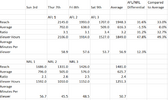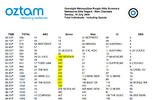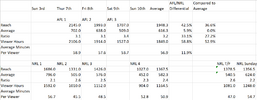The Educator
Club Legend
- Jan 23, 2023
- 1,101
- 1,138
- AFL Club
- Gold Coast
As an example of just how much of a joke averages are when comparing 2 programs with varying lengths, lets look at the FTA numbers for Friday night. The AFL v NRL averages are actually pretty similar. 638k v 576k. But when you take into account reach as well, you can ascertain that:
AFL had total 1.933m viewers that watched 59.4 minutes on average (assuming a 180 minute run time)
NRL had 1.426m viewers that watched 48.5 minutes on average (assuming a 120 minute run time)
In terms of comparing audiences, it's a blowout. The AFL had half a million more watching, and for longer. Not even close. Yet the averages make you think it was. You can't pull the 1 minute card when the AFL had a significantly longer watch time.
Reach alone is a joke, but averages, when used on their lonesome, are just as much of a joke.
You beat me to it
This is the three games we have from each code this year on FTA

Essentially we have a bit of variation but with an undeniable conclusion
On average, thus far, the AFL matches have had 1,948M watching for an average of 56.9 minutes
The NRL has had an average of 1.481M watching for an average of 50.7 minutes
So for the same "average" audience in reality you have 33% more viewers watching 12% more game time.
Using viewer hours (if you take 3 hours for the AFL and 2 hours for NRL which is probably overs for both in relatively equal proportions) you axiomatically have 50% more viewer hours
Obviously, you agree that using straight averages in your words is a "joke" and in my words somewhere between absurd and ridiculous. In my view what makes reach the best measure of TV engagement of a single sporting match of different lengths is that it corrects for the advantage of a longer match that "total viewer hours" provides
The volume figures for single matches (e.g. total minutes viewed) will almost always be higher for AFL games than NRL games because that portion of fans that watch the game from end to end will lead to a skew for the AFL
Whether there is a flaw with the reach calculation there is no rational / coherent reason to think it would be different to either code. The one game thus far (the vegas NRL match) that could have been effected by the "spill over viewers" deficiency in the reach estimate actually ended up with the biggest outlier thus far on reach / average ratios.
So while it is just an estimate (we don't, as far as I can tell, have access to the match duration for which the averages are calculated), providing the time the average person "reached" watched of a game is a pretty sound way of highlighting just how utterly absurd conlcuding the NRL with a marginally higher average - but with a third less actual viewers - "won" the ratings or (actually far worse) had "more viewers"





 .
.

